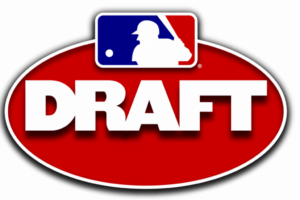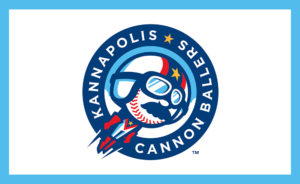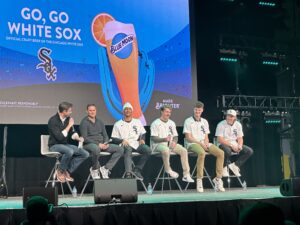Prospect arrival times and gap analysis
The discussion of prospects often focuses on ceiling and floor, and the implied value a player can theoretically bring to a team. But just as with financial investments, future value of baseball assets must be balanced against time-value. In other words, when a prospect is likely to arrive as a productive player has significant importance just as how much value they could provide. This is why our prospect profiles include a projected ETA.
A recent article from MLB Pipeline did a slice and dice of top thirty prospects from all thirty farm systems by a series of variables such as how players came to the system (draft, international, trade, etc.), position, and ETA’s. We’re going to dive a bit deeper on that last item, focusing purely on the White Sox system’s current Top 30 on our list. Here are the liner notes for our approach:
- The Estimated Time of Arrival for each prospect is going to be based on our own view – which in some cases may vary somewhat from MLB Pipeline and other sources. Obviously these are just projections, and even within each year they may not all be ready on Opening Day.
- Assumption 1: The ETA is based on a player staying with their current/likely development path. We can’t predict for injuries, prospects hitting an unforseen wall, or making an unusual jump due to organizational need.
- Assumption 2: I will assume that players’ position or pitching role won’t change from the currently-assumed likely one. Obviously if a player changes position, or a pitcher goes from starting to bullpen or vice versa, the timelines could change.
Now let’s look at some data. Here is a graphic showing the names of the current Top 30 prospects, by likely arrival year. We’ve added ranking slots to enhance it – green for top 10, yellow for 11-20, grey for 21-30…

Notice anything? That’s a big spike in 2018. More than half of the current top 10 is in there, along with a couple names that some others see as likely top 10 names in the near future if not today, like Zangari and Stephens. Overall there are twice as many prospects around the 2018 timeframe than in any other year.
This has importance in the way the team plans for the future. So let’s look at some key contracts on the major league team, and compare. Here is a graphic of the last year under control/contract for all current players on the (likely) active roster. We make a few small assumptions about who makes the team here. For those with option years, we show the last option year as their last year before free agency, as the purpose of this exercise is to look at coverage and gaps…

The good news is, if you look at the “Core” players – younger players the team is likely to be built around going forward, highlighted in green – they are mostly signed through 2019, 2020 or later. So you’re not anticipating (barring injuries or board-clearing trades) having to replace any superstars in the next three seasons, other than Todd Frazier.
But it’s not about fully replacing those players anyway, as that’s just not something you can truly rely on with even elite prospects. It’s about trying to replace the rest of the roster, ideally with upgrades or at least players on par with current production. Then maybe, a few of those players end up outperforming expectations.
Now the final look – positions. Let’s marry these two charts to show where there may be gaps, and what prospects will likely be available when other players fall away. In order to do so meaningfully, we will:
- Eliminate players (and their positions) who are signed for at least the next three years. This is because the average cycle time for high end prospects in the minors is around four years, and between that and three or four drafts, any projections that far out just aren’t meaningful. That eliminates: Jose Abreu (1B/DH), Chris Sale (SP1), Jose Quintana (SP2), Carlos Rodon (SP3), Adam Eaton (OF1), Nate Jones (RP), and Jake Petricka (RP).
- Eliminate the bench, as we’ll consider those slots easily replaceable. That eliminates Tyler Saladino, J.B. Shuck, Alex Avila and Travis Ishikawa.
- Finally, let’s ignore the bullpen. The back end is usually a crap-shoot anyway. Heck, the front end can be too. And the lead five today (Robertson, Jones, Duke, Petricka, Putnam) are all signed for at least the next two seasons. Also, some internal options that are currently starters could very well be relievers later anyway.
That now gives us the below chart. This shows the positions that will need replacement, when the current player will be gone, and which current Top 30 prospects at those positions are likely to be some kind of major league ready by that time…

Now we can focus on the biggest gaps. The top of the list above is also the biggest problem – catcher. Kevan Smith might look ready for the majors by then, but the chances of him being a reliable starter are very slim and he’s not on our current Top 30 (though he’s just outside of it). There are some catching prospects in the system with starter ceilings, but most are in some form of rookie ball (Seby Zavala, Carlos Perez, Jhoandro Alfaro). Omar Narvaez might, if everything comes together, have starting ceiling but he’s never played above High-A ball so he won’t likely be ready by Opening Day of 2017. A platoon of Narvaez and Smith in 2017 seems, unless things change, like a non-0ption.
The middle infield positions have some legitimate prospects who could be ready in time. Anderson taking over for Rollins is being treated as inevitable, though Anderson does need to refine his plate approach in AAA and get more reps in general. To replace Lawrie, you already have Carlos Sanchez “ready” now, with Eddy Alvarez and Jake Peter both heading towards 2018 at their current development. Alvarez also could play shortstop, and all three of the second basemen listed could be utility players. Sanchez may also not be in the organization that long, as keeping him in AAA for two more years doesn’t seem likely, so the Sox need to either trade him or find a major league role for him in the meantime. Middle infield, all told, is relatively low on the worry scale on this list.
Third base has some intrigue. Matt Davidson is either experiencing a dead cat bounce or he’s finally figured out a way to make reliable contact – we’ll know more in April, May and June. He’s got the power, draws some walks, and his defense is now playable, so if he can make more consistent contact he may be of value. Trey Michalczewski looks like a starting 3B to most analysts, though ever playing at a Frazier level is an unfair expectation. The hot corner seems to rate middle ground on the scale of concern on this list, with some substantial worry (beyond the low hum of unpredictability associated with relying on any prospect), but not a complete gap.
The outfield has a group of four outfield prospects worth noting, with different strengths and weaknesses as well as floors and ceilings. One slot would potentially need to open up in 2017 with Austin Jackson‘s contract being for only a year, and a second to open up with Cabrera leaving after 2017. Relying on one of the four to be ready by 2018 isn’t too much of a stretch, but expecting two of them to be starters (including one in 2017) is pretty risky. Relying on Avisail Garcia to slide back to a full time outfield slot is equally so. It’s certainly possible you get two starters from those four prospects, but I’d call the risk level here relatively high (though not as high as catcher).
You’ll also need a bat for the DH slot, which more likely either comes from outside the organization or is a slide-over from a current full-time position player, with that player then needing to be back-filled.
Last but certainly not least is the rotation. Carson Fulmer looks more and more like a major league starter, and potentially a very good one. But the cast of other arms likely to be ready by 2017 is iffy. Beck will be in physical rebuild mode in 2016 and has yet to really put it together to look like more than a 6th starter, though the potential is still there for more. Erik Johnson was flat-out dominant in AAA last year, but also struggled in 2014 and has done that again so far this spring, so there’s no telling what you get there. Brian Clark could be a major league starter, but 2017 is pushing it for him in terms of development. None of the three have ceilings higher than mid-rotation, and even that is a reach for all of them. So this, like the outfield, looks like an areas of substantial risk
If there’s good news on the starting pitcher side, it is that there is another batch of arms that would be ready more around 2018, including Jordan Guerrero, Tyler Danish, and possibly Spencer Adams and/or Jordan Stephens. So what you are really looking at here is a 2017 gap that needs addressing.
What does all this mean?
It means that 2017 looks like a season with some yawning gaps, while things look a little better starting in 2018. The primary areas of gap risk in 2017 look like catcher and 5th starter, with the outfield and DH being lesser but still patent concerns. 2017 is too soon for any 2016 draftees to make a dent; in fact 2018 is as well, except maybe a slim chance of a single outlier.
The only ways those gaps could be addressed are:
- Trades
- Free agent signings
- Position moves, which could open other gaps
- Side bets on waiver claims, Rule V selections and other corner cases, which aren’t likely to yield a starting player
- Unexpectedly fast development of a key prospect, which isn’t likely but does happen here and there
- Going with filler
That list is essentially the organization’s playbook for filling future gaps on the big board, with the first paths two being most likely to be taken. The full playbook of course involves constant attempts to upgrade all over the board, which is a larger subject, and we’re just looking at one chapter. On the key gaps, what you’re looking at is the team needing to sign or trade for near or MLB-ready talent at catcher and starting pitcher (and possibly other positions), either during the 2016 season or shortly after it.
Want to know right away when we publish a new article? Type your email address in the box and click the “create subscription” button. Our list is completely spam free, and you can opt out at any time.








Wow. A really nice job of explaining what’s the future of the White Sox. Thanks.
Thanks Dennis!